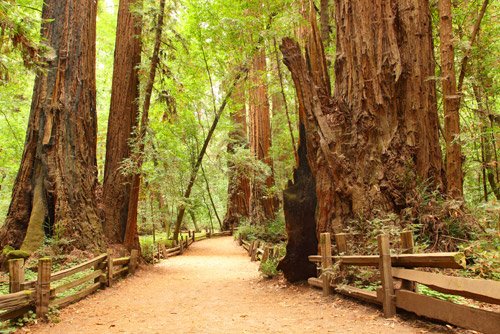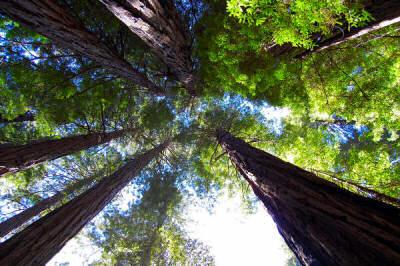Muir Woods – Ancient Redwood Forest

Enter a Peaceful World of Wonder…
Hours: 8am to sunset every day Cost: $7/person + optional donations
Not Allowed: Bicycles, Pets, Horses, Smoking, Picnics, Camping, Portable Radios
Get away from the city and relax at the majestic redwood forest of Muir Woods. Muir Woods enchanting world is just a short coastal drive of less than an hour from downtown San Francisco, over the beautiful Golden Gate Bridge, and through the scenic Marin Headland Hills. The park is affordable and has trails for just about everyone, including wheelchair-accessible trails. Muir Woods provides a terrific opportunity to see some of the oldest, tallest most amazing trees in the country. It is one of the most popular San Francisco tourist attractions and its stunning beauty is a key reason that nearly one million people visit Muir Woods each year.

About The Redwoods
In California, there are two different species of redwood trees. The coast redwood (Sequoia sempervirens) is what you will find in Muir Woods. Though most of old-growth coast redwoods have been logged, some are protected. You will find these protected redwoods in Redwood National and State Parks throughout Oregon and California. The forest at Muir Woods was spared because it was hard to access during the time that logging was running rampant.
The other species of redwood is the giant sequoia (Sequoiadendron giganteum). This type grows larger in bulk but is less tall than the coast redwood. Giant sequoias can be seen in Yosemite and Sequoia and Kings Canyon national parks. The coast redwoods are the tallest living things. The Bohemian and Cathedral groves contain the biggest trees in Muir Woods – one 252 feet tall and one 14 feet wide! When you stand beneath the immense power of these trees and look up you can’t help but be awed by the amazing offerings of nature.
Most of these trees range in age of 800-1000 years old and some may be upwards of 1500 years in age. How are these coast redwoods able to get this old? The coast redwood has been able to mature and has survived fires due to the trees’ thick bark. The bark is spongy and fibrous and can range in thickness anywhere from 6 to 12 inches. The bark acts as insulation against fire damage and other erosion. The forest’s long-term ecological wellbeing actually benefits from fires because it clears the floor of duff so redwood seeds can reach mineral soil. Additionally, the redwoods have high levels of tannic acid, which makes them very resistant to the rot that can affect other trees.

History of Muir Woods
The trees themselves are old but that’s not the only history that Muir Woods has to offer. Here are just a few of the fun facts that you’ll learn if you visit Muir Woods or research its history:
- This region was originally a home for the Coast Miwok people. They probably relied on the rich resources here for the hunting, fishing and gathering although specific details are unclear.
- Muir Woods was already beginning to become a popular place with hikers in the late nineteenth century. In fact a hiking club named the Tamalpais Club was formed earlier than 1880 and hiked in this area. Many other clubs quickly followed including the Sightseers Club, Cross-Country Club and California Camera Club. The most famous of these clubs, though, was the Sierra Club, founded by John Muir in 1892. John Muir was a well-known nature preservationist from the Bay Area and the person for whom Muir Woods was named. The area has always been active in preservation, conservation and ecological education.
-
In 1908 Theodore Roosevelt named Muir Woods the tenth National Monument; it was the first state park in the area and the first National Monument located close to a major U.S. city. Note that this was only two short years after the big earthquake of 1906 that decimated the city of San Francisco. San Francisco was in a huge revitalization period and this national monument that would ultimately be a major tourist attraction helped play a role in this.
- Up through the late 1920s you could reach Muir Woods by railway. A fire damaged railway access around this time but a local toll road as well as the Panoramic Highway were completed around the same time. The Golden Gate Bridge opened a few years later and people began to primarily reach the area by car.
- Muir Woods has been updated with maintenance over time to accommodate the annual flood of visitors. However, the redwoods themselves and the surrounding natural area remain much the same thanks to the efforts of conservationists.
Other Trees

People visit Muir Woods to see the amazing tall redwood trees of course. However, this area is rich in other amazing plant life as well. You can see Douglas Fir Treesm California Buckeyes, Red Alders, Coast Live Oaks, cedars, willows, junipers and many other broad-leaf evergreen trees and deciduous trees. You may also want to keep your eye out for wildlife including snakes, banana slugs, chipmunks, squirrels, and a wide variety of birds. Bring your camera!
Visiting Muir Woods Park
Muir Woods is open to visitors from 8 in the morning until sunset every day of the year. The visitor’s center closes about half an hour before the park shuts down. There is a charge of $7 per person to enter the state forest and you can make additional optional donations if you so choose. Children under age 16 are free. Entrance fees are waved on 12 dates of the year including National Park Week in April, National Public Lands Day on September 28th and Veterans Day Weekend. People who have a National Parks pass get in to this park for free; a $20 Muir Woods Annual Pass is also available.
There are three short self-guided walks that you can take as a Muir Woods visitor, ranging from 30 – 90 minutes in length along paved pathways. In fact there are six miles of paved, mostly level trails on the canyon floor of this 560-acre park. There are also a large number of other hikes to choose from along unpaved, more natural trails. Muir Woods does not allow camping, horses or other pets or bicycling,
The redwoods reach for all the sun they can get, and the forest floor tends to be cool and damp. Make sure to dress a little warmer for the cool, shaded, moist area. Thanks to thick fog it can sometimes be very humid, though. As is always the case with San Francisco weather your best bet is to wear layers!
Muir Woods has a visitors center where you can pick up hiking trail maps and learn about some of the history of the area. It also has a gift shop, restrooms and a cafe with locally-sourced organic foods. They also offer a wide variety of different events that you can learn about in the visitors center or check out on the official Muir Woods website. There are daily short talks by guides and sometimes there are longer one-hour guided walking tours offered by Muir Woods staff.
Most people will choose to reach Muir Woods by car since it’s the most direct option and the trip is lovely. However, there are other options if you aren’t interested in San Francisco car rental. You can take a ferry from San Francisco to Sausalito, then take a bus connection although be forewarned that the trip can take a long time this way. Another option is to take a guided bus tour that goes from San Francisco to Muir Woods; this is a great way to learn a lot about the history of the area although the downside is that you’ll be on the schedule of your tour guide instead of your own schedule. If you want to get fancy you can also take a San Francisco limo to Muir Woods.

Also In the Area
Muir Woods is a beautiful place to spend an entire day but there are also lots of other wonderful spots to see in this area. Some of the places you might want to check out while you’re in Muir Woods include:
- Muir Beach. Just west of Muir Woods you can find Muir Beach, a beautiful coastal area of dunes and water. The water is often too cold to go in but the views are stunning. If you are visiting in the autumn keep your eye out for the once-a-year migration of thousands of monarch butterflies passing right over this beach!
- Stinson Beach. This is one of the most popular beaches in the San Francisco Bay area because it offers swimming, camping, picnicking, hiking and relaxation. There are BBQ grills, restrooms and other amenities here.
- Point Reyes National Seashore. This is one of the best areas north of San Francisco for people who want to see California wildlife. There are more than three dozen threatened and endangered species of animals living here and there. You can find nearly one fifth of all California’s plant species here and almost one half of all of the species of birds in North America. It’s an amazing place!
- Mount Tamalpais State Park. Muir Woods is entirely surrounded by the land of Mount Tamalpais State Park and there are some other beautiful areas to check out in this park as well. In fact, just about two miles from Muir Woods you’ll find some of the tallest peaks of Mount Tam, which are also the tallest peaks in the region, offering incomparable views of the land below.
- Golden Gate National Recreation Area. Muir Woods and these other places are all part of the larger Golden Gate National Recreation Area which has many things to see including historic forts like Fort Baker and Fort Cronkhite, San Francisco beaches like Baker Beach and Ocean Beach, and other unique natural areas.
- Mill Valley. The closest small town is Mill Valley. Stop here to grab some lunch, meet the locals and fill up the gas tank. Mill Valley also has several hotels if you want to stay overnight in the Muir Woods area. Nearby Sausalito is a larger city with more tourist attractions that also offers some terrific accommodations.
The hustle and bustle of San Francisco offers a lot of excitement but don’t forget to take some downtime and enjoy the amazing nature of the surrounding area as well!
Map to Muir Woods:
By Kathryn Vercillo, Copyright SFTravel LLC
